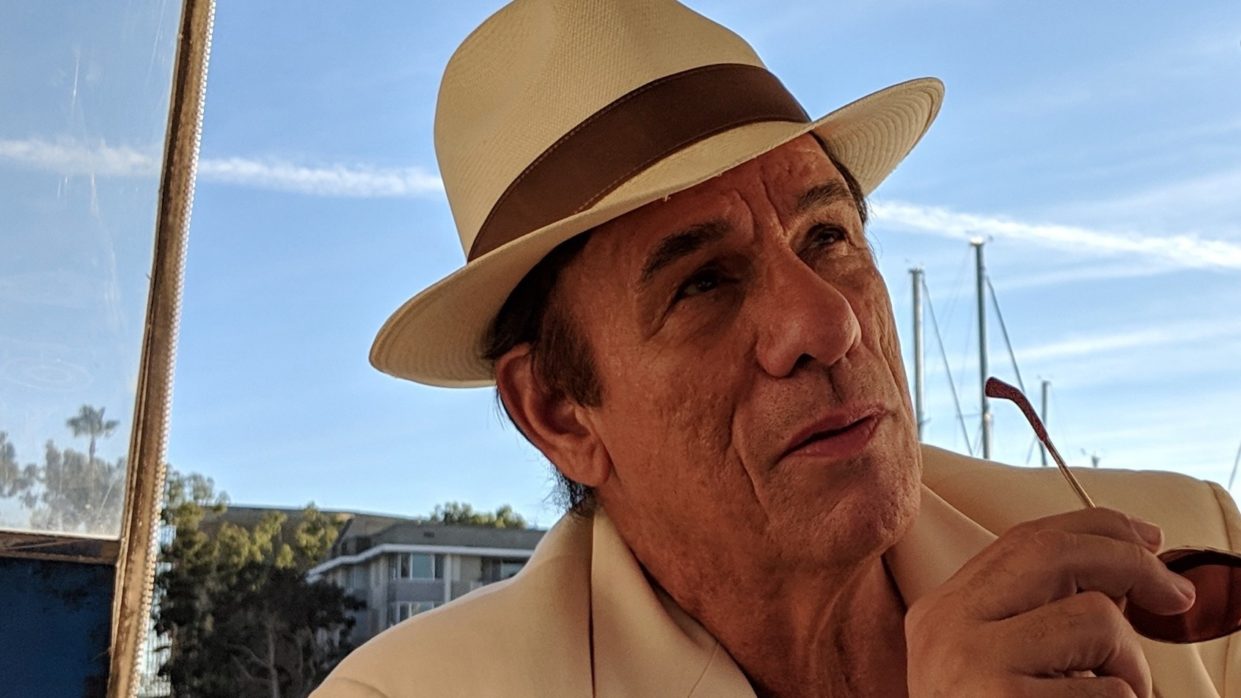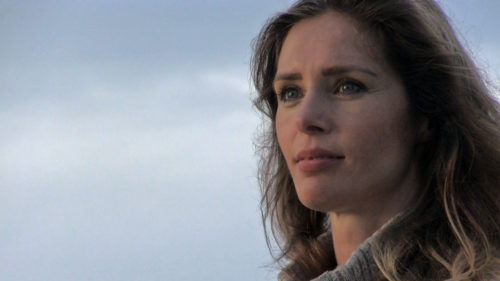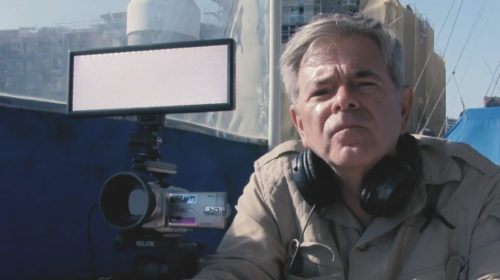 Back to selection
Back to selection
On The Making Of 8 Winds: How I Turned An Ancient Buddhist Parable Into A Contemporary No-Budget Political Thriller
 Robert Davi in 8 Winds
Robert Davi in 8 Winds How and why
What started it all was the 2016 election. I was at the Napa Valley Film Festival showing my documentary The Lost City of Cecil B DeMille, and I remember sitting in my hotel room watching the results come in and being devastated.
While in Napa it dawned on me that I had worked on many other people’s films and it was almost two decades since I had made a film of my own. I’d spent much of this time trying to get one particular project made and was not successful.
It felt like I was running out of time. That I needed to do something right now. But how? I had very little disposable cash. I hadn’t been able to raise a nickel for the one project that had consumed me to exclusion of all others. I instantly thought of Robert Rodriguez’s $7,000 El Mariachi!
I knew that under the applicable SAG new-media agreement it was possible to defer the actors salaries. I began to muse that I could make film on an El Mariachi budget! I knew I could find a “name” actor to come on board for day or two, and it would be worth it to pay him or her for their time in order to add some value to the production. Naturally this meant the budget would go up from the $2,500 goal but, there is fortune in taking the first step.
As a practicing Buddhist I always infuse my stories with some of the Buddhist values. There was a parable entitled “The Eight Winds.”
“Worthy persons deserve to be called so because they are not carried away by the eight winds: prosperity, decline, disgrace, honor, praise, censure, suffering, and pleasure. They are neither elated by prosperity nor grieved by decline. The heavens will surely protect one who is unbending before the eight winds.”
I thought it was a great title for a movie. I’ve always been a fan of noir, spy stories, and tales of espionage where the plot was a chess game. I knew this was the genre that I was going to play in.
At the Napa events I spoke to several of the winery owners and locals — there was a great deal of discussion about new water rights legislation being enacted in California. As I was mulling what my film might be about, “water” was on my mind. Forget it, Dan, its Chinatown! Yet I thought if you wanted to cripple or control an economy, attacking the water supply would be the way to go. There had been numerous stories about the Russian interference with the election. My plot was thickening! The story that evolved was about an over-the-hill filmmaker who gets drawn into an intrigue involving Russian oligarchs, a reclusive billionaire, and a nightclub owner dying of cancer.
Because of the budget, the interiors would have to be places that I controlled or could borrow, most of the exteriors would have to be shot guerilla style with little or no crew. As I anticipated shooting exteriors on the run without permits, [but with liability insurance], we would need to keep a low profile cast and crew wise.
Script
I have always believed that creativity will outshine budget. In conceiving the story and writing the script I had to write for what I controlled whether it’s locations, actors, props, and or special effects. When I say control I mean beg, borrow, steal, or own.
Because I anticipated using “in-camera sound” with only two mic inputs, it also meant no scene could have more than two talking characters at a time.
At this point I still had a few festival dates left for my DeMille film. I had the idea to have someone film me as I was attending these festivals. So I contacted the festivals and asked them if they had any local videographers who I could hire to film me. It was very low cost to hire them. This footage proved to be instrumental in establishing the character, Charlie Nabis.
I wanted to have a chase my film — I had a vision of Charlie, chasing the villain and turning the corner only to find a massive protest demonstration in his way.
You might ask how could I get a demonstration when I had no money. Los Angeles has an annual May Day march. My plan was to shoot the end of my chase against that event. Here’s a behind the scenes video on how we did the chase.
Can you “steal” a demonstration for your film? The answer is yes! Haskell Wexler in Medium Cool managed to capture very poignant and dramatic scenes with his actors against the 1968 Chicago riots. In high school we had made an award-winning film called The Incredibly Awful Doctor Sporgo and in that film two characters marched into a parade dragging a kidnapped victim. We got the shot.
For me, the most important parts of any film or how it begins and how it ends. Once I know how the story begins and ends, I can create an outline of the events that will form the plot. Once I have the plot, I can populate it with characters. The important thing is to write quickly and to get from the beginning to the end without editing or criticizing what you’ve written. You must finish while the iron is hot.
Then you need to hone your screenplay thoroughly. Show it to people whose opinion you trust and who will be radically honest. Take the notes that make sense and rewrite. I did five drafts of 8 Winds before shooting.
Casting
I had been in an “on camera” acting class for many years. I got to see a lot of actors come through the class and studied how they took direction, how they looked on camera, and what range they had. So I cast most of the supporting roles from actors I had either seen in class, worked with before, or a friend who had been on many TV shows.
How to get “name” actors? I needed two, one male, one female. Assuming you have a great script, go on IMDB Pro find out who their agents or managers are,and call them when your script is finished and you have a start date. Be prepared for a lot of “NO’s.” When you get a “no” ask them for suggestions. You might get a gift.
I had my casting team put out a breakdown for the roles of America and John Conover, the reclusive billionaire. The results were disappointing. Most of the submissions were from actors who were not well known, and the actors who were more recognizable cost more than I had.
The role of America Afrides, the female lead, was not cast until the very end of our production. We actually ran out of things to shoot, so I had to shut down production for several weeks until I could find the right actress.
On hiatus, I took another look at the submissions and I found an actress who was well known in her country, Croatia, and I remember something that producer and former agent Cassian Elwes told me: “Hire actors who are stars in their own territory, they all want to make American films, they add value to your project and won’t cost as much.”

I looked at her reel and was blown away, so I called her agent and sent her the script. Two hours later I got a self tape audition and it was spot on perfect! The negotiations were pretty heated, at one point after her agent told me “no,” I was standing at a Los Angeles Metro station about to shoot some pick up shots for the chase. I was juggling the camera in one hand and the phone in the other. I ended begging on my cell phone at the top of my lungs to get Leona Paraminski in my film. Sometimes begging works! Her performance is amazing! Here’s her Behind the Scenes video.
Casting the role of John Conover was also a roller coaster. The submissions that I got were interesting. Some of my friends had connections to very well-known actors, and I was blessed that they were willing to reach out to see if they would come aboard. Unfortunately all of them said no. However, their representatives would often make suggestions as to other clients that might fit the role. This was helpful too. You always want to make representatives your friend as much as possible because they often have a better idea of who is actually willing to work at the level you are proposing. Be realistic, it makes no sense to chase an actor that will never say “yes” because of the money/distribution/director’s credits. Previously I worked with a very well-known actor with an amazing list of credits and had become friendly with his manager. Because he had fallen on hard times his fee was in the ballpark of what we could pay. So we hired him.
About six months later, while I was editing the film I got a call from our distributor. (Yes I had a distributor before the film was finished! That has never happened to me before). He said “We have a problem.” I ask “What is the problem?” “Check the news and call me.” I looked on the internet under the actor’s name and sure enough he was now being accused of sexual misconduct. We agreed to recast and reshoot the Conover character.
I now found myself in the situation Ridley Scott had with Kevin Spacey on All The Money In The World except I didn’t have all the money in the world. I had no idea how I would raise the money needed to hire another actor and reshoot the scenes.
I began shaking the money trees, turning over every opportunity I possibly could, to find the money to reshoot the scene and finish the film. As Jean Renoir says, “Only with the intervention of divine providence have I ever been able to find money for my films.” Eventually luck smiled on me. It took me a year, but I had the money and could go shopping.
I reached out to the manager of a very well-known character actor and told him what I had in terms of a budget and he said “no way.” He did suggest several other clients of his, including Robert Davi. We made the deal and reshot the scenes. Robert Davi is a real trooper; he showed up on time, ready to work, and despite our no-budget status, he really gave a 100%. I’m truly grateful to him for that effort, and it shows in his performance. There are so many nuances it that just tickles me every time I see it. Here’s his Behind the Scenes video.
I was able to cut Davi’s footage shot in 2019 together with Charlie’s 2017 footage. They work seamlessly.
Crew

Keep it small. The largest number of crew was four or five. Not including me as director/actor. We had a cameraperson, slate operator, assistant director/continuity person/on book reader and sometimes an additional assistant/grip. Most days, and when we are on the street stealing scenes, for the most part it was just the actors and the cameraman and the slate operator. Sometimes it was just me, the camera, and a remote control. Sometimes it was me on the camera and an actor.
Actors did their own makeup and brought their own wardrobe.
I decided to adopt the Soderbergh/Chivo approach and use of available light for as much as possible. Thus no need for grip and electric, or gaffers and grips. I had two small light panels that I used from time to time, especially for the night exteriors. The only exception was the bar at the comedy club, where I rented two “2-bulb” Kino Flos in addition to my light panels. I used a frost and lavender gel on the Kino Flos to soften the light and give the bar a neon look.
Shooting the boat scene with Robert Davi, I used some diffusion material around the cabin to soften the sunlight.
Shooting
I decided to use a high-end prosumer camera and wireless mics. There were going to be days, if not weeks, were we would not shoot. By purchasing the camera and the mics I’d eliminate the need for any major equipment rental.
The total shoot was 27 days between July 6 and Septebmer 6, 2018, plus the reshoot with Robert Davi. Most of those days were half days.
Editing
I edited 8 Winds myself on Adobe Premiere.
Like writing the script, it is important to continuously hone and polish your film. There were ultimately about 13 cuts. As with the screenplay, I showed the successive cuts to people whose opinion I respected and got their notes.
Our first cut came in at two hours and 10 minutes. This surprised me because the screenplay was barely 100 pages.
At a certain point you need to throw away the script and focus on the film you have. You must be ruthless when you’re editing. If it doesn’t move the story forward it’s out! Hence characters, including one of my favorite characters, and scenes were cut.
The final running time is 93 minutes.
The QC Inquisition, No One Ever Expects The QC Inquisition!
On November 6, 2020, one month before our street date of December 3, 2020, I received an email from our distributor advising me that iTunes ran a Quality Control “QC” test on the whole film and it failed. The issues were identified as duplicate frames, ghosting and dropped frames. The report stated: “The issues are most likely caused by a poor frame-rate conversion because the footage in the film has mixed frame rates.”
“The ghosting is likely caused by one conversion mistake and the dropped frames likely caused by another. I believe the filmmaker will need to go back to the original file or editing sequence and correct the conversion issues.”
We tried fixing the problem but putting the whole film into a new timeline and did this with the trailer as a fast test by creating a new sequence with a different frame rate. This also failed, and we lost our street date.
I huddled again with my post team. They were convinced that the correct frame rate was 29.97 not 23.97, and on November 20 we devised a new approach.
But, on January 8, 2021, after transcoding the entire film to a 29.97 frame rate, we were advised that the fix still did not work!
We brought in a new postproduction expert. Upon reviewing the files it was determined that the published camera specs were not accurate. I understood the camera was shooting at 23.97 frames per second (“FPS”) in “cinema mode.” However, in fact it was a 23. 97 FPS file contained in a 29.97 FPS wrapper!
This meant that the entire film had to be reverse telecined to convert the 29.97 FPS footage to a true 23.97 FPS. The other annoying and scary thing that happened was that there was “drift” in the edits. In many places the “new version” did not conform to the “locked picture” version that I had approved. So I spent a lot of time re-conforming the edit.
This version failed too! All of a sudden the references to 8 Winds were deleted from the distributors’ websites.
From April until June 2021 the entire film had to be reviewed and any section which contained any computer-generated slow-motion sequence or digital recomposition had to be redone.
When we had a new version I ran my own QC test preemptively.
Again it failed! I began to consider the possibility that my film would never be seen by anyone. It was a low point.
I now had to track down a cameraman to replace the footage he shot. Since it was over four years I was afraid that he might not have had the original footage. He still had it and we finished the next fixed version of the film.
This time we passed QC. It was July 2021, a year after our initial delivery, and we again delivered the film to our distributor!
In December 2021, over a year after our original release date, the film was finally cleared by the platform QC as good to go.
On March 29, 2022, our five-year journey came to an end and our film was finally released to the public on demand, digital, and DVD wherever folks get their movies!
Behind the Scenes with Robert Davi
